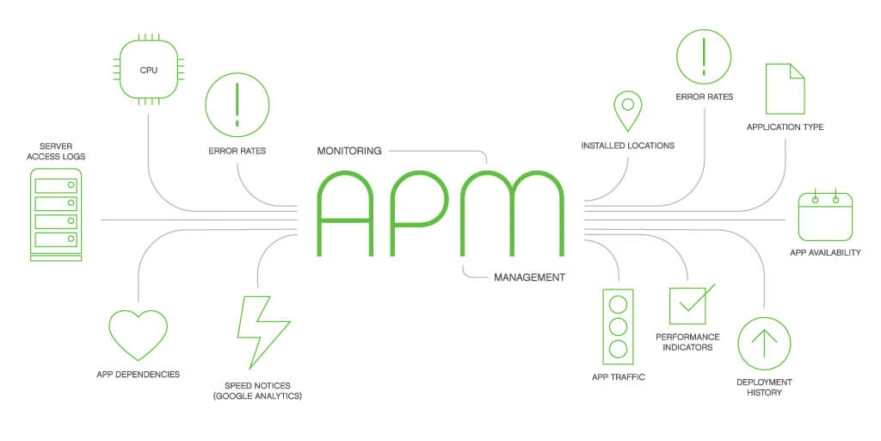Having a reliable workflow is essential for any successful application. But what exactly does it mean to monitor your application?
Knowing why monitoring your application is important will ensure that your workflow runs smoothly and efficiently, allowing you to get the most out of your app.
This blog will provide insight into why monitoring your application is so vitally important.
What is Application Monitoring?

Application monitoring or application performance management is the process of tracking and analyzing performance metrics for an application, such as CPU usage, memory utilization, network traffic, etc. It gives you insight into how your application is performing and can help you identify potential issues before they become more serious.
It ensures the optimal performance and user experience. It involves monitoring various aspects of an application, including its availability, responsiveness, resource usage, and error rates.
Application monitoring typically involves collecting data from different sources, such as application logs, server metrics, network traffic, and user interactions. This data is then analyzed to generate insights and metrics that provide a comprehensive view of the application’s performance.
Why monitoring your application is important?
Improved Performance
By monitoring your application, you can identify potential performance issues and take corrective action before they become a problem. This will help your users have a better experience and allow them to get the most out of your application.
Improved User Experience
You can ensure a smooth user experience by monitoring your application. If there are any issues that arise during the use of the application, they can be easily identified and addressed before they become major problems. This will help keep users from experiencing any poor performance or frustration while using the application.
Ensured Security and Compliance
Application monitoring can help you ensure that your application is secure and compliant with industry regulations. Monitoring will provide visibility into security vulnerabilities and potential compliance issues, allowing you to address them before they become serious problems.
Increased Profitability
Monitoring your application can help improve the profitability of your business by providing insight into what areas are performing well and which areas may be suffering. This allows for improved decision-making and more efficient resource allocation, improving the bottom line of your business.
Increased Reliability
A reliable workflow is essential for any successful application. Monitoring allows you to identify any issues that may be causing your application to malfunction, helping you ensure its reliability.
Capacity Planning and Scalability
It can help you anticipate usage patterns and workloads, allowing for better capacity planning and scalability of your application. This will help ensure that it is able to handle future demand without any problems.
Proactive Maintenance & Troubleshooting
Monitoring your application can help you stay ahead of any potential problems or performance issues. It allows you to quickly take action before the issue develops into something more serious.
Improved Visibility
It gives you an in-depth look into how your application is performing and provides valuable insights that can help you make informed decisions about its future development.
Different Types of Application Monitoring
There are several types of application monitoring which are listed below.
Server Monitoring: Focuses on server performance and availability, such as CPU usage, memory utilization, disk space, network traffic, etc. Features include system resource utilization tracking, alerting & notification capabilities, log management, etc.
Network Monitoring: Observe the health and performance of your network, including the availability of various network components. Features include uptime & latency tracking, bandwidth usage analysis, etc.
Application Monitoring: Focuses on the performance and functionality of an application. Features include response time measurement, error rate tracking, throughput & load testing, etc.
Database Monitoring: Observes the performance and stability of your database. Features include query performance tracking, index usage analysis, deadlock detection, etc.
Security Monitoring: Focuses on ensuring that an application is secure from external threats. Features include malware scanning & removal, intrusion detection & prevention systems, vulnerability assessments, etc.
Cloud Monitoring: Checks the performance and availability of cloud services such as Amazon Web Services (AWS), Microsoft Azure, Google Cloud Platform (GCP), etc. Features include performance metrics tracking & alerting, resource utilization analysis, cost optimization, etc.
Choosing the Right Application Monitoring Systems
There are various application monitoring systems available that provide comprehensive monitoring solutions for businesses of all sizes.
Some of these include:
- Datadog: A monitoring service for cloud-scale applications, providing monitoring of servers, databases, and tools.
- Dynatrace: An artificial intelligence-based software intelligence and monitoring system.
- ManageEngine: A tool to effectively monitor and troubleshoot application performance issues.
- AppDynamics: Observability platform designed to help organizations monitor, troubleshoot, and optimize the performance of applications.
- New Relic: A cloud-based software analytics platform providing real-time monitoring, diagnostics, and performance management.
- Logentries: A cloud-based log management and analytics platform providing real-time log monitoring, search, and analysis capabilities.
Each system offers different features and pricing plans to meet your unique business needs.
Read Also: How to Make Mac Dark Mode?
Best Practices for Effective Application Monitoring
- Define clear monitoring goals and metrics.
- Implement proactive monitoring with automated alerts.
- Monitor end-user experience for insights into user satisfaction.
- Monitor key performance indicators (KPIs) specific to your application.
- Utilize real-time monitoring for immediate visibility into application health.
- Monitor critical components such as servers, databases, and APIs.
- Leverage logs and error tracking for troubleshooting and analysis.
- Utilize application performance monitoring (APM) tools for comprehensive insights.
- Monitor scalability, capacity, and resource usage.
- Establish baseline performance and benchmarks for comparison.
- Regularly review and refine your monitoring strategy.
- Foster collaboration between teams for effective monitoring processes.
Quick Read: What is ChatGPT Playground and How to use it?
Conclusion
Application monitoring is very important because it is essential for maintaining the performance and stability of your applications.
By implementing the right application monitoring system and following best practices, you can ensure that your application remains resilient and reliable.
Monitoring activity should be ongoing and monitored carefully to maximize its effectiveness.



